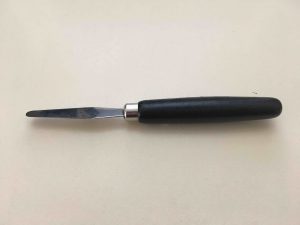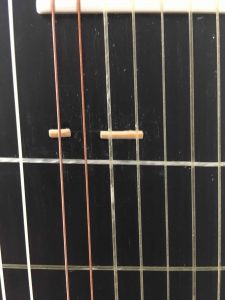Today, Cleartune finally provided an app update after multiple IOS updates and nothing from them. It is now compatible with IOS 11.
Glued on Frets
Years ago during our lessons, Paul O’Dette recommended that I attach my tastini with glue as he did, but I resisted because when I would change the tastini for whatever reason (new temperament, new string, etc.), I would make a mess of it. Recently, however, Grant Tomlinson showed me how to easily remove a glued on fret or tastino with a very thin palette knife such as the one pictured on your left. This led me to adapt Paul’s approach, and now I am much happier with the glued on tastini than the taped on tastini I recommended in the book. They are more secure and look better without the little icky feeling you get when your fingers touch the tape or that faint crinkling sound you hear if the tape isn’t completely flush.


Here’s how it looks on my theorbo. Much nicer, don’t you think?
Why a Blog?
One of the fun things about researching a book such as Meantone Temperaments on Lutes and Viols is that you never stop learning even after the ink has long dried. The purpose of this blog is to provide updated information as I discover new things about tuning lutes and viols. I hope these new nuggets of knowledge or experience can help you as they’ve help me.
PitchLab
PitchLab became available on IOS and thus accessible to me just before the book’s proofs were due, which did not leave me enough time to do anything more than report that it was a powerful and versatile app particularly for string players. As you know, in the book, I highly recommended Cleartune and still do, however, when I recently received the warning from Apple that Cleartune might not be available after the next system update, I started to use PitchLab more and have grown to love it. PitchLab has so many modalities that makes it a versatile tuner; in fact, I think I can tune more accurately with it than with Cleartune. And, though I’ve never felt comfortable with strobe tuners before, PitchLab’s version is very easy to use. Finally, it shares one of the primary advantages that Cleartune offers—the ability to create your own temperament, which as you know is going to be more precise than the preloaded meantone temperaments that don’t tell you where the wolf is. What’s more, creating new temperaments in PitchLab is even easier than in Cleartune. Given that we may not have Cleartune around much longer, I think it behooves us all to become more familiar with PitchLab.
Mixing Tuners
As I’ve started to use PitchLab, I’ve noticed that it doesn’t seem to be calibrated in quite the same way as Cleartune, so until someone figures it out, I recommend that all instruments in an ensemble be tuned by the same model tuner with the exact same settings in terms of the ET offset charts. When I don’t have to consider what others are doing, I’m sticking with PitchLab.